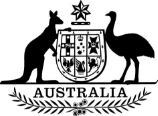
I, Yvette Berry, Acting Chief Minister for the Australian Capital Territory, make the following declaration.
Dated 30 June 2025
Yvette Berry
Acting Chief Minister

I, Yvette Berry, Acting Chief Minister for the Australian Capital Territory, make the following declaration.
Dated 30 June 2025
Yvette Berry
Acting Chief Minister
1 Name
2 Commencement
3 Authority
4 Simplified outline of this instrument
5 Definitions
6 Exemption
7 Human Rights Act statement.....................................3
This instrument is the Automatic Mutual Recognition (Australian Capital Territory) (Exemption—Dangerous Substances and Labour Hire Provider) Declaration 2025.
(1) Each provision of this instrument specified in column 1 of the table commences, or is taken to have commenced, in accordance with column 2 of the table. Any other statement in column 2 has effect according to its terms.
Commencement information | ||
Column 1 | Column 2 | Column 3 |
Provisions | Commencement | Date/Details |
1. The whole of this instrument | 1 July 2025. |
|
Note: This table relates only to the provisions of this instrument as originally made. It will not be amended to deal with any later amendments of this instrument.
This instrument is made under section 42S of the Mutual Recognition Act 1992 of the Commonwealth.
The purpose of this instrument is to exempt registrations for dangerous substances occupations, activities covered by dangerous substances licences and labour hire providers or licensing from the automatic deemed registration provisions of the Mutual Recognition Act 1992 of the Commonwealth until 1 July 2030 because of a significant risk to the health and safety of workers or the public. This instrument has effect only in relation to the Australian Capital Territory.
Unless revoked earlier, this instrument will sunset under section 50 of the Legislation Act 2003 of the Commonwealth, subject to subsection 42S(6) of the Mutual Recognition Act 1992 of the Commonwealth. This will generally mean that this instrument will be repealed on the first 1 April or 1 October falling on or after the fifth anniversary of the registration of the instrument on the Federal Register of Legislation.
In this instrument:
Act means the Mutual Recognition Act 1992 of the Commonwealth.
(1) For the purposes of paragraph 42S(1)(a) of the Act, a registration in column 1 of the table in subsection (3) of this section is excluded from the operation of automatic deemed registration in the Australian Capital Territory.
(2) For the purposes of subsection 42S(2) of the Act, column 2 of the table in subsection (3) of this section sets out a statement of the risk to consumer protection, the environment, animal welfare or the health or safety of workers or the public in relation to each registration in column 1.
(3) The table is as follows:
Exemptions for the purposes of paragraph 42S(1)(a) | ||
Item | Column 1 Registration | Column 2 Statement of risk |
1 | Dangerous substances licences issued under the Dangerous Substances (Explosives) Regulation 2004 and the Dangerous Substances (General) Regulation 2004. | There are significant health and safety risks in the ACT, particularly concerning dangerous substances. The AMR scheme, while promoting workforce mobility, may reduce regulatory oversight because it only requires a one-time notification to work, weakening ongoing engagement with regulators like WorkSafe ACT. For dangerous substances, this could delay risk mitigation, especially given the high number of interstate workers. |
2 | Licensing provided under the Labour Hire Licensing Act 2020. | There are significant risks that AMR may limit the availability of up-to-date information on operational industries, hindering compliance and enforcement. These exclusions help maintain robust oversight and support the development of a nationally consistent regulatory framework. |
(4) This section is repealed on 30 June 2030.
Section 40B(1) of the Human Rights Act 2004 (ACT) provides that it is unlawful for public authorities to act in a way that is incompatible with a human right or, in deciding, fail to give proper consideration to a relevant human right. Accordingly, in making the exclusions in section 6, I have considered any relevant human rights that may be impacted as required by s40B. Section 27B(1) of the Human Rights Act 2004 provides that everyone has the right to work, including the right to choose their occupation or profession freely. I am satisfied that the making of the exclusions in section 6 would not be incompatible with the right to work and the right to choose an occupation or profession freely.
While the exclusions may limit the right to work, it is important to note that the making of the exclusions does not prevent an individual from carrying on an activity covered by dangerous substances or labour hire occupations in the ACT. Rather, the making of the exclusion will mean that all individuals who wish to carry on an activity covered by dangerous substances or labour hire occupations in the ACT must meet particular registration requirements set out in ACT law. Upon meeting the relevant registration requirements, individuals would be able to carry on an activity covered by dangerous substances or labour hire occupations in the ACT. The registration requirements are a necessary, proportionate and reasonable measure through which safeguards are provided to protect workers. Any limitation on the right to work is reasonable and justified because the exclusion will allow the ACT to address risks associated with the application of AMR while ensuring there is no diminution in current levels of safeguards in relation to the health and safety of workers or the public.